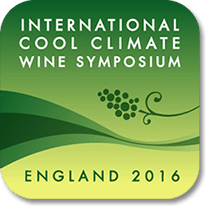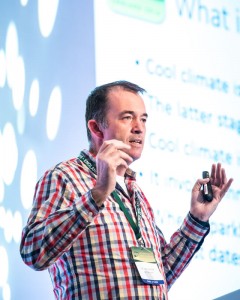 How do you define a “cool climate” wine region? According to the folk behind this year’s International Cool Climate Wine Symposium, the distinguishing characteristic is how much sleep the winemaker gets. Warm climate = easy winemaking (lots of sleep) = bad. Cool climate = difficult winemaking (less sleep) = good. All I can say is that I don’t think that anyone invited winemakers from, say, Umbria, Rioja, or Pasa Robles, and I didn’t see any blood shed. Then again, we were in England.
How do you define a “cool climate” wine region? According to the folk behind this year’s International Cool Climate Wine Symposium, the distinguishing characteristic is how much sleep the winemaker gets. Warm climate = easy winemaking (lots of sleep) = bad. Cool climate = difficult winemaking (less sleep) = good. All I can say is that I don’t think that anyone invited winemakers from, say, Umbria, Rioja, or Pasa Robles, and I didn’t see any blood shed. Then again, we were in England.
Everyone agrees that no one agrees on how to distinguish (evidently desirable) cool climes from (evidently less desirable) warm ones. So much the better, because that means that we can learn something by arguing about them. So, from my observations at the Symposium, here are ten rules for defining “cool climate.”
- Growing degree days – Many fruiting plants (at least in theory) only grow when the ambient temperature rises above some baseline. The relevant baseline varies from plant to plant; for grapevines, it’s 50° F. Growing degree days adds up all of the time a plant spends above that baseline and uses that number as an indication of, essentially, climate that counts. Take the average temperature on every day of the year in Fahrenheit (often measured as the daily high plus the daily low, divided by two) and subtract 50. Add together all of the positive numbers – cold days don’t count in this system – and you have growing degree days for your location.
According to Dr. A. J. Winkler, one of the University of California Davis’s first eminent wine scientists in the 1930’s, “cool climate” wines have fewer than 2,500 growing degree days per growing season. The advantage to that definition is that it’s simple and quantitative; your numbers say you’re that cool climate, or they don’t. The disadvantage is that those numbers don’t correspond to anything meaningful, at least not very well. We don’t actually care about temperature; we care about how the wine tastes or, if you’re a viticulturalist, about what to do in the vineyard. With all respect due to Dr. Winkler, growing degree days fail to give us much help there.
- Other ways to add up temperature – …Which is why numerous other systems have cropped up to replace the growing degree day. Growing degree days’ simplicity is it’s weakness: it works from average daily temperatures and assumes that all heat, at any time, has the same effect. We all know that’s not right. A steady 65°F all day is a darn sight different than a high of 95°F in the shade at lunchtime that becomes 35°F when night falls, but in growing degree day terms, they’re equals. Plant scientists and climatologists continue to devise all manner of other mathematical formulae to deal with that issue, all trying to extract the variability that really matters for vine performance or wine quality from the mountains of detail that a model just can’t handle.
- Geography – A little old-fashioned, but you still see some attempts to generalize about cool-climate by geography. It’s the message of every New World winery that compares its latitude with (insert Fancy French Wine Region here): we’re the same distance from the equator as folks who sell their wine for hundreds or thousands of dollars, so ours must be a good place for winemaking and our bottles are a bargain for $34.99.
 The 45th parallel north – half-way between the equator and the North pole – runs through the French Rhône-Alps, Italy’s Piedmont, Oregon and Michigan’s Leelenau Peninsula in the United States, Ontario in Canada, and Croatia and part of Khazakstan. Ontario is hosting the next Cool Climate Wine Symposium in 2020. Entrepreneurs in the Leelenau Peninsula are slowly working out how to vinify something other than cherries and semi-sweet hybrid wines. Meanwhile, while Piedmont and its neighboring regions over the French border aren’t exactly tropical, no one thinks about calling Barolo “cool climate.” Regional topography and local geography have too great an effect on climate for sheer angle of the sun and day length to be useful indicators for oenophiles.
The 45th parallel north – half-way between the equator and the North pole – runs through the French Rhône-Alps, Italy’s Piedmont, Oregon and Michigan’s Leelenau Peninsula in the United States, Ontario in Canada, and Croatia and part of Khazakstan. Ontario is hosting the next Cool Climate Wine Symposium in 2020. Entrepreneurs in the Leelenau Peninsula are slowly working out how to vinify something other than cherries and semi-sweet hybrid wines. Meanwhile, while Piedmont and its neighboring regions over the French border aren’t exactly tropical, no one thinks about calling Barolo “cool climate.” Regional topography and local geography have too great an effect on climate for sheer angle of the sun and day length to be useful indicators for oenophiles.
- Viticultural concerns – The problem with #1-3 is that they try to work as universal models, and they’re going to do a better job of understanding how climate patterns affect life as a grapevine in some locations and for some grapevines better than others. An alternative is to stop asking meteorological records quantitative questions and start asking vineyard managers qualitative questions. Do you deal with cool climate issues? Do you worry about your vines freezing in the winter? Do you obsess over weather data during dinner on spring evenings, hoping that a late frost won’t interrupt bud break? Do you keep up with research from Cornell and Minnesota on cold-hardy rootstocks? Then you’re working in a cool-climate region.
- Wine style – But maybe being cool climate isn’t about viticulture at all. At the end of the day, do we care about how chilly the vines felt in February, or about how the wine tastes sitting on our dinner table? “Cool climate” is a rallying call for viticulturists to talk about a particular set of shared problems. It’s also a marketing tool, and short-hand for a set of wine styles. If you prefer transparent, fine-boned pinot noirs over full-bodied, brickish ones, you’re going to be directed toward “cool climate” wines. At that point, the designation really has nothing to do with frosts or growing degree days and everything to do with taste. You can try to make cool climate wines in areas located a bit closer to the equator than seems reasonable; just ask the Californians.
- Quality – Cool climate wines are better than warm climate ones, right? And everyone with good taste prefers cool climate wines, just like we all prefer dry wines and are just buying those cloyingly sweet red blends because our friends want to drink them at parties. If a wine is really good, it’s probably cool climate, right?
- Fashion – Did you see “cool climate” as a branding strategy twenty years ago? Not much. Will you see it twenty years hence? Who knows.
- Money and marketing – The cynic in me thinks that “cool climate” sometimes has more to do with a region’s marketing budget than with whether the marketers wear Uggs or flipflops to work. If you’ve had enough money to rebrand yourself over the past five years, you’ll have found a way to work “cool” into the message somewhere.
-

Jamie Goode presenting at the IWCCS. (photo: Julia Clayton/IWCCS) Tradition – Is cool climate about temperature, or about style? About style, or about image? Wine styles aren’t just about the raw materials you have, but about who you want to be. For some wine regions, who you want to be is about connecting to history and maintaining tradition. Germany and Austria (or at least parts of Germany and Austria) have been lands of cool-climate whites and reds. At the Symposium, we heard from wine scientists at Germany’s Geisenheim University that where twenty years ago they needed to think about frost prevention, today they’re worried about over-ripeness and sunburn. Are they still a cool-climate region? Maintaining that tradition of classic wine styles seems more important – at least to consumers – than whether the University has needed to change its research program to maintain those styles.
- Membership – I like the definition of “cool climate wine” that Jamie Goode gave in his closing remarks. Being cool climate is about deciding that you want to be cool climate, not about falling above or below the threshold of any quantifiable marker. More than liking it, I think that definition is useful. In academia, scholars do all manner of different kinds of research in English departments, in anthropology, in geography, in history. What makes you a professor of one versus the other is less about the kind of research you do, more about about the crowd you hang with and the kinds of conversations you want to have. The Cool Climate Wine Symposium gave me the same feeling – here, we have a gathering of people who want to have similar conversations. That orientation, that sense of common identity, is going to express itself in the way members think about viticultural problems, and wine styles, and marketing images, and in the kinds of wines that consumers see. So maybe the best way to answer the question, “Are you a cool climate wine region?” is, “Do you want to be?”
